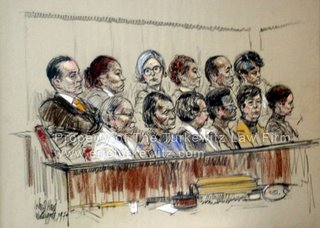 New York’s jury selection rules have always appeared a bit Byzantine. They vary from county to county and at times from judge to judge. In one place you use the “Struck” method and may question 30 or more jurors at once, and in another you question just the first six (White’s Rules). Sometimes lawyers immediately replace jurors when they are excused for cause or consent, and other times you wait until the end of the round when you do the peremptory challenges. Most places the plaintiff and defendant alternate each round as to who must exercise challenges first, and in some places the plaintiff is forced to go first in every round.
New York’s jury selection rules have always appeared a bit Byzantine. They vary from county to county and at times from judge to judge. In one place you use the “Struck” method and may question 30 or more jurors at once, and in another you question just the first six (White’s Rules). Sometimes lawyers immediately replace jurors when they are excused for cause or consent, and other times you wait until the end of the round when you do the peremptory challenges. Most places the plaintiff and defendant alternate each round as to who must exercise challenges first, and in some places the plaintiff is forced to go first in every round.
It was enough to drive an otherwise sane lawyer batty. But now some of that may change, as Chief Administrative Judge Ann Pfau has issued this guide for judges and lawyers on how to implement the rules. Are they standard now? Of course not. But with a guide, that everyone should print out and bring to jury selection, at least things may run a bit more orderly because the issues are more sharply defined.
Oddly enough, our courts still can’t seem to standardize our method of selection, as the guide tells us:
The Uniform Rules for the Trial Courts provide for two methods of jury selection — White’s or Struck. Counsel shall be given the opportunity to select the method they prefer, provided that the court will select the method if the parties cannot agree.
You would think that, after a couple hundred years of practice with the jury system, we could at least resolve the simple issue of picking a system of picking.
I also have an issue with the timing of when potential jurors are replaced, either on consent or for cause. Do you handle those two categories on the spot (and then immediatey fill the vacant seat) or wait until you are off in the hallway just moments before you exercise peremptory challenges for cause? As per the guide:
In each round, consent excusals and challenges for cause of jurors ‘in the box’ shall be exercised prior to exercise of peremptory challenges and as soon as the reason therefor becomes apparent. When a juror is removed from the box for cause or on consent, that juror is immediately replaced, and questioning reverts to counsel for the plaintiff.
The problem with this system is that, when you kick someone right after they’ve uttered the magic words (“Does your client think the jury system is a lottery?”), you’ve also given information to the rest as to exactly what kind of story they need to tell to be bounced from jury service. While most folks can figure this out pretty easily, there seems to be little reason to telegraph just how easy it can be.
There are good parts as well. For instance, I will no longer be told to question 30 jurors in one hour, as I have been told to do on occasion. According to the guide:
Instead of setting time limits for questioning, the recommended practice is for the judge or [Judicial Hearing Officer], based on the consultation, to set only a general time period after which counsel should report on the progress of voir dire. In a routine case a reasonable time period to report on the progress of voir dire is after about two or three hours of actual voir dire and, if requested by the judge or JHO, periodically thereafter until jury selection is completed.
The guide also gives sharp definition to the Struck method, which has varied from place to place with respect to when challenges are used in various rounds. The court says that, if using this method, there is just a single round of challenges, to be exercised only after you have enough cause-free panelists to fill the jury:
After the general voir dire of the full panel, counsel’s questions focus on the first 16 prospective jurors in the randomly selected panel. If any prospective are excused by consent or cause challenge after both sides have questioned the first 16, the questioning proceeds with the prospective jurors occupying seats 17 and higher until there is a total of 16 ’cause-free’ jurors.
I’d like to think that this guide is a work in progress and not a finished product. One, single, standardized system of selection throughout the state would most surely make life easier. And after a couple hundred years of practice, we ought to be up to that task.
And if you want the story on the artwork I’ve used for this bit, you can check it out here (But please excuse the horribly self-promotional text at the link. That needs to be re-written.)
Links to this post:
New York Brings (Some) Clarity to Jury Selection Rules
https://newyorkpersonalinjuryattorneyblog.com/2009/01/new-york-brings-some-clarity-to-jury.html. New York’s jury selection rules have always appeared a bit Byzantine. They vary from county to county and at times from judge to judge. …posted by Jury Experiences @ January 24, 2009 8:13 PM
posted by Walter Olson @ January 16, 2009 12:41 AM

